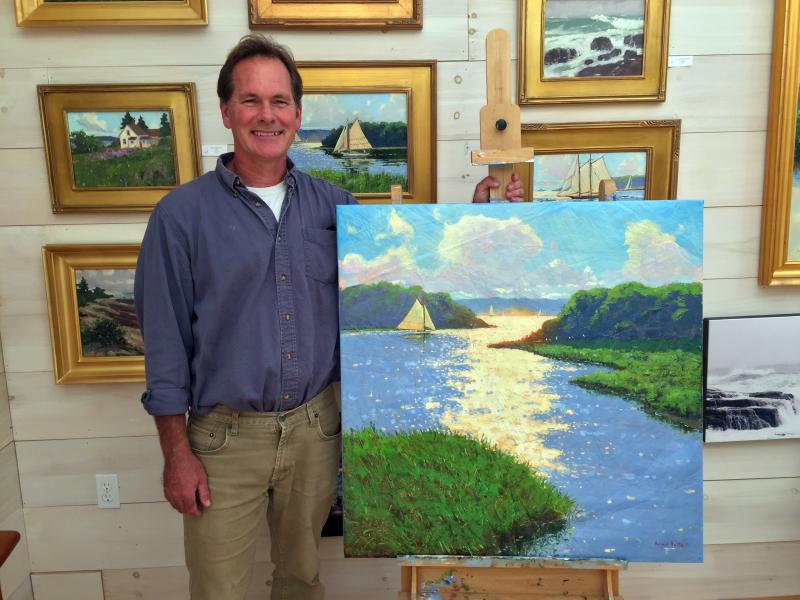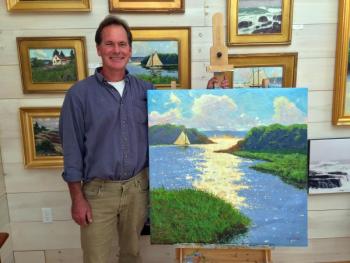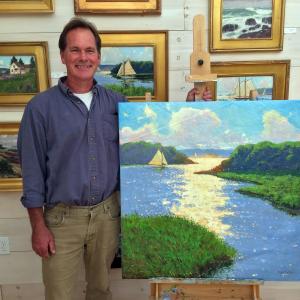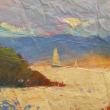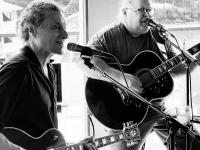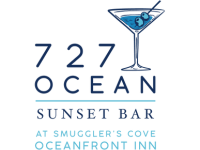Brad Betts, impossible dreams and serendipity
When Brad Betts was approached about donating a painting for an auction in Florida, there was a slight hesitation. Very slight. As soon as the reason for asking him to paint and give away a painting that would normally fetch upwards of $7,000 was made clear, he was sold.
This past summer, a boat sailed into Boothbay Harbor with owner Deborah Mellen, her dog Winter, a captain, Will Rey, and first mate Evan Duffy. There were also two three-foot-square pieces of old sails that had needed to be replaced. When the Impossible Dream sailed out of the harbor the next day, one of the squares remained. Now, two months later, that panel of sail is a painting, stretched on a frame, with Brad Betts' signature at the bottom right.
Mellen is a wheelchair user. The Impossible Dream is a 60-foot universally designed, ocean-going catamaran built to accommodate, and be operated by, wheelchair-bound people. The boat has shown thousands of paraplegics and quadriplegics they can do things they hadn't dreamed possible before sailing on it. Its home base is the Shake A Leg organization in Miami, founded by Harry Horgan, also a wheelchair user. Its mission is to help people with mobility disabilities maximize their independence through sailing and other water-based activities.
The Impossible Dream has sailed to Boothbay Harbor twice — once during the summer of 2015, and again this past summer.
During the voyage up the east coast that began in Miami, Mellen and other crew members met with 30 artists and asked each to paint or fashion some type of art, on the three-foot-by-three-foot panels of old sailcloth that were brought along. The finished works would be auctioned off at an event that will take place on Oct. 29 at Shake A Leg's 25th anniversary celebration to raise money for the foundation.
Brad Betts was the artist chosen from the Boothbay area.
On Oct. 29, the Art of Sail exhibit, curated by Dave McCauley of Rise Up Gallery will feature the paintings and other forms of art done by Betts and the 29 other artists selected to participate.
Known for his seascapes and local scenes, Betts was asked to participate because of his artistic talent, but it appeared that serendipity had a part in it, too. In 2004, Betts was asked to help a quadriplegic, Stephen Libby, learn to paint — using his mouth. Initially the artist declined. He was busy with two young sons and getting his art career started, and it was a daunting prospect.
A few days later, Libby called him and asked him to give it a shot. Betts relented.
“I had preconceptions of what it would be, but we started painting, and it was so much better than I thought it would be,” he said. “Stephen was patient and determined. He had been a sketch artist before becoming disabled. What I thought would be very hard to do was really very easy.
“It was a life-changing experience for me. He's the one who ended up helping me. He changed the way I paint. He taught me patience and he taught me determination. My career, that I was so worried about at that time, just started to flow more smoothly.”
Together, the artists created a new kind of palette — on a tripod, designed so that the wheelchair could roll up to it. Even with his limited mobility Libby was able to do everything he needed to, unassisted.
Thanks to Betts’ help, Libby was accepted into an organization he had been dreaming of becoming a part of — Mouth and Foot Painting Artists. Handicapped people are selected through a rigorous jury selection. Note cards, prints and calendars are printed from members’ paintings, and the artists are able to make money from the sales.
The oil painting, titled ”Sunlit Passage,” is now on its way to Florida. The Impossible Dream sails in the distance, in the painting. “It's the kind of scene I love doing,” Betts said. “This was fun for me. Stephen Libby impacted my life, and there was no question that I wanted to be a part of this.”
Betts’ son, Sam, now a senior at Boothbay Region High School, wrote an essay when he was in the ninth grade. The paper was about pride, and Steven Libby.
The words “impossible job“ and “impossible goals” were used in the essay, written four years before the Impossible Dream sailed into Brad Betts’ life.
‘I believe essay’
By Sam Betts
“I believe that anyone can achieve their dreams as long as they have self-resilience and pride in what they do.
“I remember going to this man's house when I was little. I would sit on his big leather couch and watch Star Wars with my older brother while my dad taught him how to paint ... He is a quadriplegic. This man can't move anything below his neck, and even then, can only turn his head the width of a football, left and right. Thirty years ago, he was involved in an accident. He has been in a chair ever since. He can't do many of the regular things others do everyday. He can't lift a fork to feed himself, he needs a nurse to do that for him. He can't go for a walk, throw a ball, itch his nose. He received money from the government because of his disability, so he didn't need a job, but he wasn't proud of that fact; it was not the way he wanted to live.
I remember when my father got the call from him, asking if he would teach him how to paint. It was an impossible job. My father refused; he couldn't imagine how to teach a man to paint when he couldn't use his hands. The next day or so he called again. This man would not relent. He did not take no for an answer. He insisted that my dad just give it a try and he finally convinced him. Once every two weeks, my dad would go to his home and would often bring me along, as I couldn't stay home alone.
This man learned how to paint using only his mouth. He and my dad painted the same painting, at the same pace, step by step. It took a long time, but this man had patience, and he had motivation, and he had pride. This man strived to be self-reliant, and against all odds, he accomplished his goal. About 10 years ago, he made it through a rigorous selection process and was accepted in the association of Mouth and Foot Painting Artists (MFPA). He had reached his goal and began making his own income through sales of his artwork. This man did not want charity. Despite his physical condition, he felt driven to accomplish something in his life that could allow him to be more self-reliant.
As I grew, I didn't think about him that often, but I never forgot about him. I think of him now; I admire his work ethic; I admire his way of thinking; I admire how he set impossible goals; I admire that he accomplished them. His work inspired people. I know he inspired my dad, who built him a special easel that kept paint within reach of the man's brush in his mouth. I didn't know it at the time but he inspired me too.
While this man ended up selling his paintings, his true accomplishment was much more. This man had pride. And because of that, he was able to accomplish his dream. And because of this man, I believe in self-reliance and pride in everything we do.”
Event Date
Address
United States

